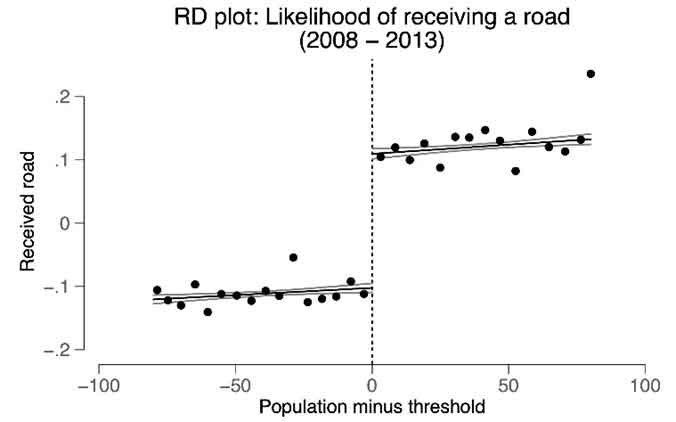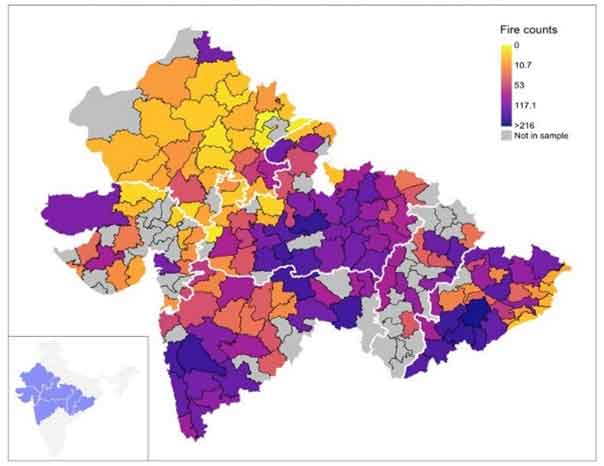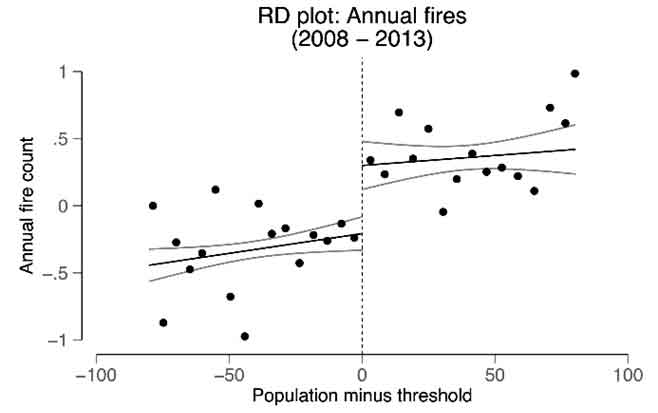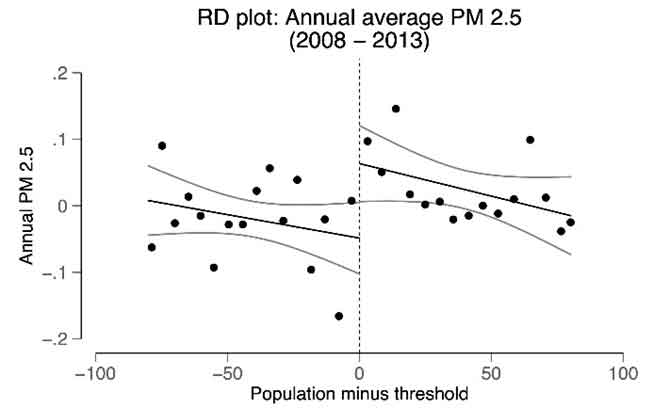While the process of moving workers from low- to high-productivity sectors is considered critical for economic development, its environmental impact remains largely unexplored. This article shows that the exit of workers from agriculture, enabled by access to rural roads, induces farmers to use fire – a labour-saving but polluting method – to clear agriculture residue.
Structural transformation – the process of moving workers from low-productivity sectors such as agriculture to high-productivity sectors such as manufacturing and services – is viewed as a critical engine for economic development (Lewis 1954). However, whether policies that facilitate such intersectoral reallocation of workers have harmful effects on the environment, is an open question. In particular, reallocation of workers out of agriculture can prompt farmers to adopt labour-saving technologies with a higher carbon footprint. We examine this question in the context of agricultural worker exits and crop fires in India (Garg et al. 2020).
Our analysis focusses on India's flagship rural road construction programme – the Prime Minister's Gram Sadak Yojana (PMGSY) – which facilitated movement of workers away from agriculture. To estimate the impact of rural roads, we leverage the eligibility rules in PMGSY that are based on population thresholds (Asher and Novosad 2020): villages with a baseline population (as per the 2001 Census) just above the specified threshold were more likely to receive a new road under the programme than villages with a population just below the threshold. The fact that the villages on either side of the threshold are, on average, similar in terms of other characteristics, allows us to isolate the causal impact of the roads using a regression discontinuity design (RDD).1
We combine administrative information on road construction under the PMGSY, with satellite-based estimates of crop fires and air pollution. Starting from the early 2000s, the PMGSY aimed to provide all-weather road connectivity to previously unconnected villages. The programme prioritised villages with a population above 1,000, followed by villages over 500, and then villages under 500. Our sample is restricted to those states for which, and the time period (2008-2013) during which, these population threshold rules were followed.2 Within each state, we identify the universe of eligible villages that had no road connectivity at baseline (2001 Census), resulting in a sample of around 11,000 villages. In Figure 1, we first show that there was compliance with the PMGSY rules in this sample – villages above the population threshold see a 23-percentage point increase in the likelihood of receiving a road compared to villages just below the threshold.
Figure 1. Likelihood of villages receiving a road under PMGSY, 2008-2013
Impact of rural roads on fires and air pollution
To measure the impact of the roads on fire activity, we use data from NASA's MODIS (Moderate Resolution Imaging Spectroradiometer)-Aqua and Terra satellite systems. These satellites detect infrared radiation associated with biomass fires at a 1-km (kilometre) spatial resolution at a daily level (Csiszar et al. 2006). We aggregate the daily fire-pixels data observed within a 10-km radius around sample villages to the yearly level to use as our main outcome variable. While much of the media and policy attention is focused on stubble-burning in Punjab and Haryana in Delhi's vicinity, satellite data show that crop fires are common across many other parts of the country as well, including the states in our study sample (Figure 2).
Figure 2. Average annual fire activity in sample villages
Figure 3a presents the annual fire activity across the population threshold. We see that villages above the programme’s threshold experience a sharp jump in the number of fires relative to villages below the population cut-off for road assignment. Our empirical estimates show that the increase is about 2.6 additional fires per year (a 70% increase relative to the average of the control group – the group that did not receive roads).
Figure 3a. Annual crop fires around the population threshold, 2008-2013
The increase in crop fires also results in a corresponding decline in air quality. We measure pollution using satellite and atmospheric model-based estimates of the annual average PM2.5 (Donkelaar et al. 2016). The use of remote sensing data allows us to overcome the challenges posed by the lack of ground-level air pollution monitors across rural India. Analogous to the effect of roads on fires, we observe a large and statistically significant increase in PM2.5 for villages just above the population treatment threshold (Figure 3b). The corresponding estimates show an increase of 1.3% (0.5 g/m3) in PM2.5. This impact on pollution is quite substantial: based on existing ‘dose-response’ estimates in the literature (Liu et al. 2019), a 0.5 g/m3 increase in PM2.5 implies an increase in daily all-cause mortality by 0.03%.
Figure 3b. Annual average PM2.5 around the population threshold, 2008-2013
Is the increase in PM2.5 driven by mechanisms other than crop fires?
Rural roads could contribute to air pollution through channels other than crop fires alone. For instance, new roads increase transportation, and the resulting vehicular emissions could plausibly worsen air quality. They could also lead to other pollution generating activities such as construction or setting up of new firms. We test for this possibility by examining the seasonal effect of roads on fires and sources of pollution emissions. We rely once again on climate-model data from the Modern-Era Retrospective analysis for Research and Applications, Version 2 (MERRA-2) covering our sample period. MERRA-2 provides monthly data on emissions and apportions these emissions into those arising from biomass burning alone (driven by crop fires) and all other anthropogenic factors such as transportation, industrial emissions, or other combustion sources. If crop fires are the primary mechanism through which roads increase pollution, we would expect a larger impact on emissions during those months when roads increase fires compared to other months. Second, we should see a higher effect on biomass emissions compared to other sources.
The results that we find are consistent with these hypotheses. We show that the increase in fires and emissions is concentrated in the winter harvest and post-harvest months (October - March), and is muted during the rest of the year. The winter months correspond to the period where farmers benefit from the use of fires in the face of agricultural worker exits - either to clear harvest (rice) residue off fields within a narrow time window before planting in the next season, or to make (sugarcane) harvesting less labour-intensive. We also see that the increase in PM2.5 is driven by emissions from biomass burning, with null effects on emissions from all other anthropogenic sources. Together, these results strongly suggest the overall impact on pollution is likely to be driven by crop fires rather than other channels such as vehicular emissions, industrial activity, or other such factors.
How do we know that agricultural worker exits drive the increase in crop fires?
Results from previous research on the impact of PMGSY (which we replicate in our study) show that rural roads singularly affect worker exits from agriculture (Asher and Novosad 2020). But they had relatively little effect on mechanisation, yields, assets, consumption, or other economic outcomes that could drive farmers to engage in crop-residue burning. We further bolster our central claim that agricultural worker exits increase crop fires by sub-sample analyses across baseline worker wage rates and cropping patterns. If agricultural worker exits were the primary driver for an increase in crop fires, one would expect to see effects concentrated in areas which see a larger the movement of workers out of agriculture and where the prevalence of rice or sugarcane – crops that benefit most from the use of fire in the face of agricultural worker exits – is greater.
We find that rural roads' impact on the decline in the share of workers in agriculture is most pronounced in districts where the relative agricultural wage is lower (below median) at baseline. Villages within districts where the relative agricultural wage is higher (above median) see no effect. These results suggest that roads facilitate worker movement across sectors only where worker reallocation returns are the highest. Correspondingly, we find that the increase in crop fires is concentrated in districts with lower relative agricultural wage rates. Second, as one would expect, rural roads' effect on crop fires is significantly larger in districts with a higher prevalence of rice or sugarcane. Finally, we combine variation in relative agricultural wage rates and rice or sugarcane production. The increase in crop fires and particulate emissions is concentrated in districts with a higher rice or sugarcane production and where the relative agricultural wage is lower at baseline, with comparatively modest effects in other districts.
Implications for policy
The results of the study suggest that workers’ exits from agriculture compel farmers to use a labour-saving but polluting technology – fire – resulting in adverse consequences for air quality. Our work builds on recent literature examining trade-offs and synergies between economic development and environmental quality. The persistence of a worker productivity gap across agriculture and non-agricultural sectors has generated considerable interest amongst governments and international agencies to devise policies that reduce frictions in worker reallocation across sectors. Our research underscores the need to complement these policies with strategies to mitigate their potential adverse environmental externalities. In this context, future research could investigate the design and implementation of monetary and non-monetary incentives to alter farmers' decisions to engage in using fire in agriculture in the face of soaring worker costs (Jack and Jayachandran 2019).
A previous version of this article was originally published on the World Bank Development Impact blog.
I4I is now on Telegram. Please click here (@Ideas4India) to subscribe to our channel for quick updates on our content.
Notes:
- Regression discontinuity design is an econometric technique used to estimate the effect of an intervention when the potential beneficiaries can be ordered along a cut-off point. The beneficiaries just above the cut-off point are very similar to those just below the cut off. The outcomes are then compared for units just above and below the cut off to estimate the causal effect of the intervention.To estimate the effect of rural roads on crop fires and PM2.5 (particulate matter), we employ a ‘fuzzy RDD’, due to imperfect compliance of the PMGSY with the population threshold rules).
- Our sample is based on Asher and Novosad (2020) who worked closely with the National Rural Roads Development Agency to identify the states that followed the PMGSY rules for population thresholds. The states in our sample are Chhattisgarh, Gujarat, Madhya Pradesh, Maharashtra, Orissa
Further Reading
- Asher, Sam and Paul Novosad (2020), “Rural Roads and Local Economic Development”, American Economic Review, 110 (3): 797-823.
- Csiszar, Ivan, Louis Giglio and Christopher O Justice (2006), “Global distribution and seasonality of active fires as observed with the Terra and Aqua Moderate Resolution Imaging Spectroradiometer (MODIS) sensors”, Journal of Geophysical Research Biogeosciences, 111(G2).
- Donkelaar, Aaron van, Randall V Martin, Michael Brauer, N Christina Hsu, Ralph A Kahn, Robert C Levy, Alexei Lyapustin, Andrew M Sayer and David M Winker (2016), “Global Estimates of Fine Particulate Matter using a Combined Geophysical-Statistical Method with Information from Satellites, Models, and Monitors”, Environmental Science & Technology, 50(7): 3762–3772.
- Garg, T, M Jagnani and HK Pullabhotla (2020), ‘Agricultural Labor Exits Increase Crop Fires’, Working paper.
- Jack, B Kelsey and Seema Jayachandran (2019), “Self-selection into payments for ecosystem services programs”, Proceedings of the National Academy of Sciences, 116(12): 5326-5333.
- Lewis, Arthur W (1954), “Economic Development with Unlimited Supplies of Labour”, The Manchester School, 22(2): 139-191.
- Liu, Cong, Renjie Chen, Francesco Sera, Ana M Vicedo-Cabrera, Yuming Guo, Shilu Tong, Micheline SZS Coelho, Paulo HN Saldiva, Eric Lavigne, Patricia Matus, Nicolas Valdes Ortega, Samuel Osorio Garcia, “Ambient Particulate Air Pollution and Daily Mortality in 652 Cities”, New England Journal of Medicine, 381(8): 705-715.




 22 December, 2020
22 December, 2020 








Comments will be held for moderation. Your contact information will not be made public.